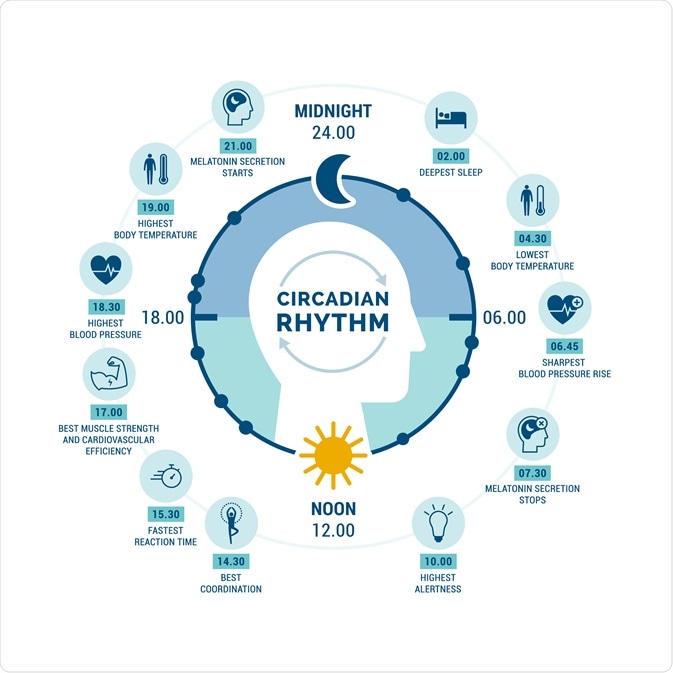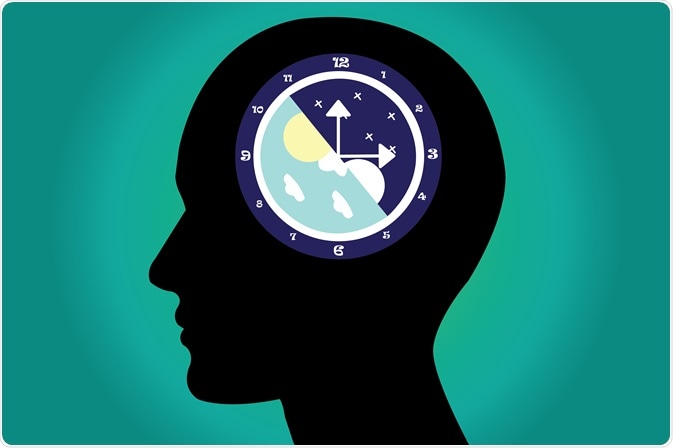Circadian rhythm refers to the physical, mental and behavioral changes that occur in most living things over a 24-hour cycle, primarily regulated by the light or darkness of the surroundings. It is distinct from the biological clock, but the two are related as the biological clock controls the circadian rhythm and the related processes in the body.
 Infographic of a conventional circadian rhythm. Image Credit: elenabsl / Shutterstock.com
Infographic of a conventional circadian rhythm. Image Credit: elenabsl / Shutterstock.com
Natural circadian rhythm
The circadian rhythm is responsible for regulating periods of sleepiness and wakefulness throughout each day and night. In a normal and healthy person, the rhythm naturally dips and rises, changing the level of sleepiness of the individual.
The urge to sleep arising from the circadian rhythm peaks between 2 am and 4 am for most people and rises again in the afternoon between 1 pm and 3 pm, although the exact times can vary for each individual. The strength of these urges depends on the quantity of sleep in the preceding days and is more intense when a person is sleep-deprived. The circadian rhythm also results in periods of increased alertness at other times of the day.
How Your Circadian Rhythm Tunes Your Health: Satchin Panda at TEDxYouth@SanDiego 2013
Physiological processes
The circadian rhythm is regulated by the suprachiasmatic nucleus (SCN) of the hypothalamus in the brain. These cells respond to signals of light and darkness from the surrounding environment via the optic nerve from the eyes. The light stimuli then trigger signals from the SCN to other parts of the central nervous system (CNS) to regulate hormones, body temperatures and other mechanisms that play a role.
For example, when the eyes are exposed to higher intensity of light in the morning, the SCN signals for the brain raise the body temperature, increase the production of the cortisol hormone, and delay the release of the melatonin hormone.
Delayed circadian rhythm in teenagers
It has been observed that teenagers tend to have a delayed circadian rhythm, with respect to children and adults. This means that the cortisol and melatonin levels rise and reach a peak later than usual, which can cause difficulty in getting to sleep. In some cases, particularly when early morning routines are necessary for school or other activities, teenagers may have difficulty getting enough sleep and are more likely to become sleep deprived.
 Image Credit: kanyanat wongsa / Shutterstock.com
Image Credit: kanyanat wongsa / Shutterstock.com
Circadian rhythm and jet lag
International travel and changing of time zones can disrupt the natural circadian rhythm and cause difficulty sleeping, particularly in the first few days as the body adjusts to the new environment.
Related sleep disorders
Circadian rhythm sleep disorders involve an abnormality in the timing of the alertness and sleepiness of an individual, which can have an impact on their daily function. These disorders include:
- Delayed sleep phase disorder (DSP): most common in adolescents and young adults, DSP involves feeling tired and waking up at least two hours later than is considered normal.
- Advanced sleep phase disorder (ASP): most common in middle-aged and older adult, ASP involves feeling tired and getting up at least two hours earlier than is considered normal.
- Jet lag disorder: occurs when an individual changes time zone quickly (e.g. air travel), which misaligns the rhythm to the external environment
- Shift work disorder: occurs when the work schedule of an individual interrupts the normal sleep period, which can cause sleepiness during the shift and change patterns of sleepiness.
- Irregular sleep-wake rhythm: involves an irregular sleep cycle, often fragmented into several names throughout the day and is linked to insomnia and sleep deprivation
- Free-running type: also known as non-entrained type involves a variable sleep cycle that shifts later each day, irrespective to the light in the surrounding environment.
The clock in our genes and in every cell of your body | Joseph Takahashi | TEDxSMU 2013
References
Further Reading